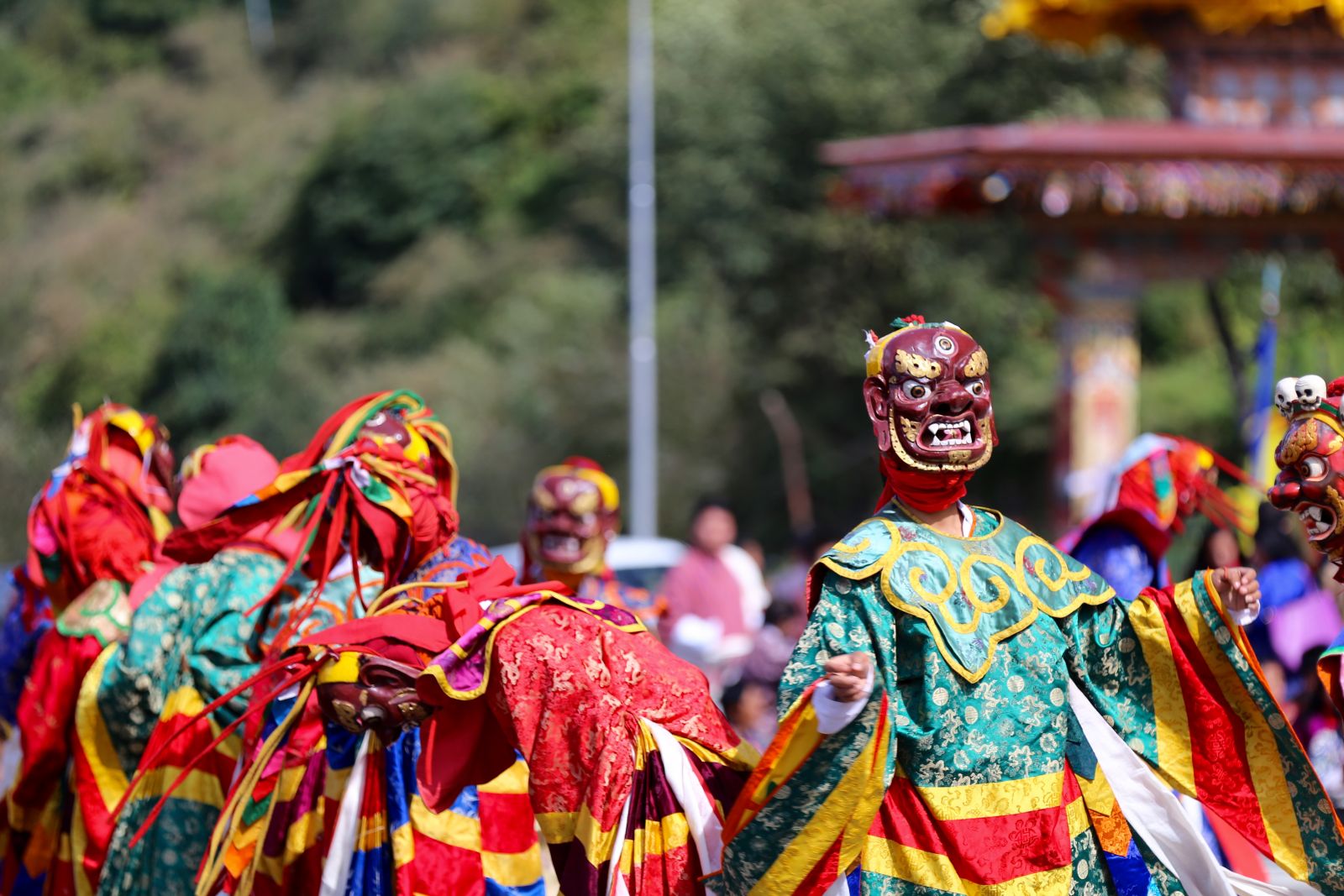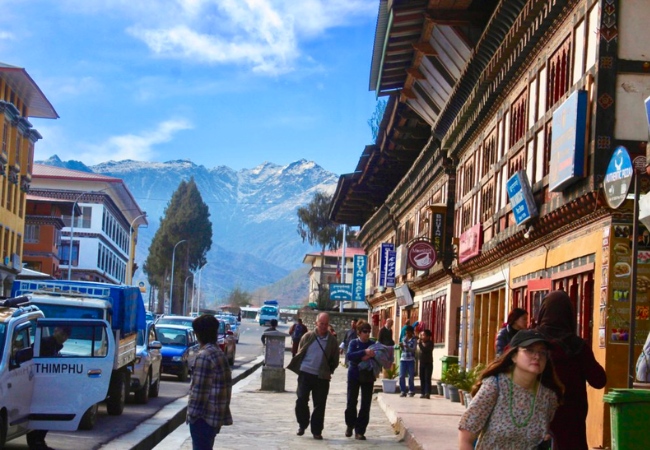Places to visit in Paro
Book Tour
.jpg)

Paro is a beautiful and culturally rich town located in Bhutan, known for its stunning landscapes, historic monuments, and ancient temples. Here are some of the top places to visit in Paro:

Paro Takshang
- Taktshang Monastery, also known as Tiger's Nest, is a sacred site and iconic landmark located in Paro. The monastery is perched on a cliff 900 meters above Paro Valley, surrounded by beautiful natural scenery. It is considered one of the most important Buddhist pilgrimage sites in the world and is visited by thousands of people every year.
According to legend, Guru Rinpoche, also known as Padmasambhava, flew to the site on the back of a tiger in the 8th century to meditate there for three months. He is said to have subdued local demons and introduced Buddhism to Bhutan during his stay. The monastery was later built in the 17th century around the cave where Guru Rinpoche meditated.
The Taktshang Monastery is a complex of four temples, interconnected by staircases and bridges, and features beautiful murals, statues, and carvings. Visitors must trek up a steep and narrow trail to reach the monastery, but the breathtaking views of the valley and the monastery itself make the journey well worth it.
The Taktshang Monastery is not only a spiritual site but also a symbol of Bhutan's cultural identity and national pride. It is an important destination for tourists and a source of inspiration for artists, poets, and writers.

National Museum
- National Museum of Bhutan, also known as Ta-dzong, is a historic museum located in Paro. It is housed in an ancient watchtower that was built in the mid-17th century to defend Paro Dzong, the fortress-monastery that served as the administrative center for the district. The watchtower was converted into a museum in 1968 and has been open to the public ever since.
The National Museum of Bhutan showcases the country's rich cultural heritage and traditional art. It features a wide range of exhibits, including textiles, paintings, weapons, stamps, and coins, as well as rare objects and artifacts that date back to the 6th century. The museum also has a gallery that displays photographs and paintings of Bhutan's kings, queens, and royal family members.
The National Museum of Bhutan is an important cultural institution that preserves and promotes Bhutan's unique identity and heritage. It is a popular destination for tourists who want to learn more about the country's rich history and cultural traditions. The museum's location, perched on a hill overlooking Paro Valley, also offers visitors stunning views of the surrounding mountains and landscapes.
.jpg)
Paro Rinpung Dzong
- Rinpung Dzong, also known as Paro Dzong, is a historic fortress-monastery, built in the 15th century on a hill overlooking Paro Valley and serves as the administrative center for the district. The dzong is a fine example of Bhutanese architecture and is considered one of the most beautiful and well-preserved dzongs in the country.
Rinpung Dzong is a complex of buildings that includes a central tower, courtyards, temples, and administrative offices. The dzong is surrounded by high walls and a moat, and can be accessed by a traditional wooden bridge over the moat. The interiors of the dzong are adorned with intricate murals, thangkas, and statues that reflect Bhutanese culture and Buddhist traditions.
Rinpung Dzong is not only a religious and cultural site but also an important center for the community. It is the venue for many important events and festivals, including the Paro Tsechu, a colorful and vibrant festival that takes place every year in the dzong. The dzong is also home to a monastic community of over 200 monks who live, study, and practice there.
Rinpung Dzong is a must-visit destination for tourists who want to experience Bhutan's rich culture and history. The dzong's strategic location, stunning architecture, and beautiful interiors make it one of the most popular tourist attractions in the country. Visitors can explore the dzong, attend festivals and events, and enjoy the serene and peaceful surroundings of the monastery.

Drukgyel Dzong
- Drukgyel Dzong is a historic fortress located in the upper part of the Paro Valley and the name "Drukgyel" translates to "the fortress of the victorious Drukpas," which refers to the Bhutanese people. The dzong was built in the 17th century by the Zhabdrung Ngawang Namgyal, the founder of Bhutan, to commemorate Bhutan's victory over Tibetan invaders.
The Drukgyel Dzong has played an important role in Bhutan's history as it served as a strategic point of defense against invaders from Tibet. The fortress is surrounded by beautiful scenic views of the Paro Valley and snow-capped mountains, making it a popular destination for tourists.
The fortress is a unique example of Bhutanese architecture, featuring thick walls and beautiful wooden galleries. The dzong is home to several temples and shrines, including a temple dedicated to the guardian deity of Bhutan, Gyaltshen.
Today, the Drukgyel Dzong is in ruins due to a fire that broke out in the 1950s. However, efforts are being made to restore and preserve the fortress. Visitors can explore the ruins of the dzong and learn about its history and cultural significance.

Kyichu Lhakhang
- Kyichu Lhakhang, also known as Kyerchu Temple, is a Buddhist temple located in Paro. It is one of the oldest and most sacred temples in Bhutan, built in the 7th century by Tibetan Emperor Songtsen Gampo.
Kyichu Lhakhang is considered to be one of the most important temples in Bhutan as it is believed to have a significant religious and cultural value. The temple is home to many precious and ancient Buddhist artifacts, statues, and murals that showcase the richness and diversity of Bhutanese art and culture.
The temple is surrounded by a serene and peaceful atmosphere, making it a popular destination for both locals and tourists seeking solace and spiritual enlightenment. Visitors can explore the temple's beautiful architecture, learn about its history and significance, and take part in daily prayers and rituals performed by the resident monks.
Kyichu Lhakhang is also a place of pilgrimage for many Buddhists, who come from all over the world to offer their prayers and seek blessings. It is said that by visiting the temple, one can receive blessings, good health, and protection from negative energies and spirits.

Jangsarbu Lhakhang
- Jangsarbu Lhakhang is a small and unique temple in Paro. The temple is known for its fascinating history and legends, as well as its impressive architecture.
According to legend, the temple was built by the 11th century Tibetan King Songtsen Gampo as part of his efforts to subdue a demoness who was obstructing the spread of Buddhism in the region. The temple was later renovated in the 15th century by the famous saint and architect, Zhabdrung Ngawang Namgyal.
Jangsarbu Lhakhang is known for its intricate paintings and carvings that depict various stories and legends from Bhutanese mythology. The temple also houses several ancient artifacts, including old weapons and prayer books.
Visitors to Jangsarbu Lhakhang can learn about the temple's fascinating history and cultural significance from knowledgeable guides. They can also witness the daily prayer rituals and offerings made by the temple's resident monks.
The temple's unique architecture, featuring a blend of Bhutanese and Tibetan styles, is another major draw for visitors. The temple is located on a small hill and offers stunning views of the surrounding Paro valley and mountains.

Dumtse Lhakhang
- Dumtse Lhakhang is a unique and unusual temple located and is known for its impressive architecture and intricate murals that depict various Buddhist deities and stories.
Built in the 15th century by the famous Tibetan saint and architect, Thangtong Gyalpo, Dumtse Lhakhang is one of the few surviving examples of Bhutanese temple architecture from this era. The temple is shaped like a chorten or stupa and is adorned with elaborate carvings and paintings.
Inside the temple, visitors can see a series of intricate murals that cover the walls and ceilings. These murals depict various Buddhist deities and stories, including the eight manifestations of Guru Rinpoche and the 21 Taras. The murals are particularly notable for their vivid colors and intricate details.
In addition to its impressive architecture and murals, Dumtse Lhakhang is also known for its peaceful and serene atmosphere. The temple is surrounded by lush greenery and offers stunning views of the surrounding valley and mountains.
Visitors to Dumtse Lhakhang can learn about the temple's fascinating history and cultural significance from knowledgeable guides. They can also witness the daily prayer rituals and offerings made by the temple's resident monks.

Chele La Pass
- Chele La Pass is a picturesque mountain pass located between Paro and Haa valleys. It is one of the highest motorable passes in Bhutan, offering breathtaking views of the surrounding Himalayan peaks and valleys.
At an altitude of 3,988 meters above sea level, Chele La Pass is a popular destination for tourists and locals alike. The pass is surrounded by lush forests of rhododendrons and is home to a wide variety of flora and fauna, including the elusive snow leopard.
One of the main attractions of Chele La Pass is the stunning view of Mount Jomolhari, which is considered to be one of the holiest mountains in Bhutan. Visitors can also take a leisurely hike along the many trails in the area, enjoying the fresh mountain air and stunning scenery.
Another popular activity at Chele La Pass is birdwatching. The pass is home to a variety of bird species, including the Himalayan Monal, Blood Pheasant, and Satyr Tragopan. Visitors can observe these beautiful birds in their natural habitat, with the help of local guides.
Chele La Pass is also known for its vibrant prayer flags, which adorn the surrounding hillsides and add to the area's peaceful and serene atmosphere. Visitors can participate in traditional Bhutanese prayer flag ceremonies, which involve offering prayers and attaching new flags to the existing ones.

Kila Goenpa Nunnery
- Kila Goenpa Nunnery is situated on the route to Haa from Paro, en route to the Chele La Pass. It is approximately 27 km away from Bondey Paro. The word "Kila" is derived from Sanskrit, which means a subjugating spiritual dagger that eliminates negativity. The nunnery is also known as Chele La Goenpa. To reach the nunnery, there is a diversion road before reaching the Chele La Pass, from where one can either hike or take a car. The total distance to the nunnery is around 2.5 km from the diversion.
Visitors are pleasantly surprised to witness the simple and serene lifestyle of the nuns, who coexist in harmony with Nature. The nunnery is situated at the base of a mountain, providing a serene and peaceful environment, far from the noise and chaos of the towns. It is located at an elevation of 3,500m and houses seven small temples and several retreat huts.
One can hike to the nunnery through a hiking trail from the Chele la and takes around an hour and half. The trail passes through pine forests and steep slopes.

Bumdra Temples
- Bumdra is a sacred site located above Paro valley. It is a popular destination for trekkers and hikers due to its stunning natural beauty and religious significance. The site features a temple, meditation huts, and prayer flags that serve as landmarks on the trek. The trek to Bumdra begins at the Sang Choekor Monastery and leads through the forest and forestry ridge, offering hikers a glimpse of Bhutan's untouched nature. After about two hours of hiking, the Chhoe Tse Lhakang temple marks the first landmark. The trek continues until a clearing is reached with a breathtaking view of the Paro and Do Chhu valleys, known as Bumdra. Visitors can witness a beautiful sunrise and interact with various wild birds that come for feeding in the morning and evening.

Tachogang Lhakhang
- Tachogang Lhakhang is approximately 10 kilometers away from Paro town. It is known for its unique architectural style and historical significance. It was built in the 15th century by the famous architect, Thangtong Gyalpo, who was also a renowned iron chain bridge builder.
One of the main highlights of the temple is the iron chain bridge that connects the temple to the other side of the Paro Chhu river. This bridge was built by Thangtong Gyalpo himself and is still in use today. The bridge offers a thrilling experience as visitors walk across it while feeling the movement of the chains and the sound of the river below.
Tachogang Lhakhang is also famous for its intricate wall paintings and statues of Guru Rinpoche and other important Buddhist figures. Visitors can explore the temple and learn about its history and significance from the resident monks. The temple is surrounded by beautiful natural scenery, making it a perfect spot for a peaceful retreat or a scenic picnic.

Chungphu Hermitage
- To reach Paro Chungphu, one of the most sacred sites in Bhutan, visitors must embark on a five-hour hike from the road point. The journey begins at the opening gate, also known as Zee Go, which is formed by two standing rocks. As visitors make their way towards the temple, they will encounter numerous rocks and cave formations that are associated with Guru Rinpoche, each with its own story and significance.
The highlight of Paro Chungphu is undoubtedly the Dorji Phagmo statue, also known as the "floating" statue. This sacred and ancient statue depicts the goddess Dorji Phagmo, also known as Vajravarahi, who is believed to have flown from Tibet and remained at the temple in the form of a statue. The life-sized statue is particularly remarkable because one of her legs is crossed at the knees while the other stands without touching the ground.
According to local belief, visitors can test the statue's floating quality by passing a money note below her feet, which supposedly passes through smoothly without a hitch. In addition to the Dorji Phagmo statue, visitors can also explore the Guru Rinpoche Caves at Chumbu, which include several caves used by Guru Rinpoche himself, as well as caves used by his consorts, Khandro Mendharawa and Khandom Yeshey Tshokey.

Paro Weekend Market
- Weekend Market in Paro is a vibrant and bustling market held every Saturday and Sunday in the heart of Paro town. It is a popular destination for both locals and tourists, offering a wide variety of fresh produce, handicrafts, and local delicacies.
The market is located near the main town of Paro. Visitors can wander through the market's many stalls, browsing the colorful displays of fruits and vegetables, handmade textiles, pottery, and other local crafts.
One of the highlights of the Paro Weekend Market is the food section, where vendors sell a variety of traditional Bhutanese dishes, such as momos (steamed dumplings), phaksha paa (pork with chili and radish), and ema datshi (chili and cheese stew). Visitors can sample these dishes, along with fresh fruit juices and local teas, as they explore the market.
The Paro Weekend Market is also a great place to interact with locals and learn more about Bhutanese culture. Visitors can watch as vendors weave textiles or carve intricate woodwork, or they can strike up a conversation with a friendly Bhutanese farmer selling fresh produce.

